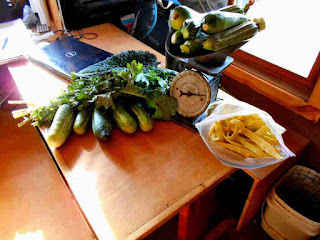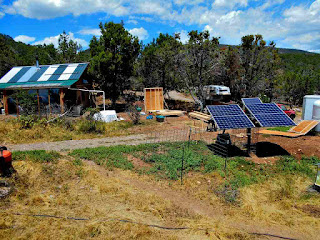September - harvesting and building!
It was a really cool and rainy spring and summer, so the veggies were slow to ripen in the garden, but once they started too, it was really hard to keep up with it all. Eat it, give it away, dry it, can it, freeze it, root cellar, we tried everything, and somehow, it all got used. We averaged 6 lbs of zucchini a day for a month or so. Here's a sampler of our yearly total for some of the summer harvest from garden and hoophouse:
Cooked greens - 340 lbs
Salad greens - 65 lbs
Wax beans - 16 lbs
Zucchini - 297 lbs
Tomatoes - 270 lbs
Rhubarb - 27 lbs
With all of the rain and irrigation water, the pasture stayed greener longer this year. The goats enjoyed all that greenery and Jeanne happily struggled to keep up with all of the milk, making yogurt, cheeses, cream, butter, and gradually taking on more customers. The total for the year ended up being a little over 4000 lbs of milk! Abundance is stressful in a ways, because you don't want it to go to waste, but it has a much nicer feel to it than scarcity.
Meanwhile, Linc kept building and digging. He maneuvered the backhoe in behind the cabin and began excavating for an addition on two sides for a two room root cellar, a solar battery/outhouse room and an attached outdoor kitchen for summer cooking without having to carry pots up the hill to the current summer kitchen.
The backhoe also came in handy for digging up one of the main irrigation valves that was leaking. Linc took it out, found nothing wrong, put it back in, and it hasn't leaked since. This seems to happen a lot for him; take it apart, look at it, put it back together, and it's fixed, but no idea why!
He also used the backhoe to excavate for the next winter's growing beds for the mobile hoophouse. Because we were down to caliche (clay and rock-hard alkali mineral precipitate), he dug down two or three feet for each bed, threw cottonwood logs and branches to create sunken bed hugelkultur (see http://www.richsoil.com/hugelkultur/), backfilled, and then mixed compost and soil amendments into the top 4". These beds were then planted with cold-hardy winter greens, carrots, and beets and left until we could find time to de-anchor the hoophouse, roll it down the rails over the new beds (once the tomatoes were done in the summer beds), and anchor it back down against the winter winds.



































